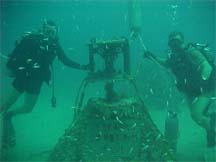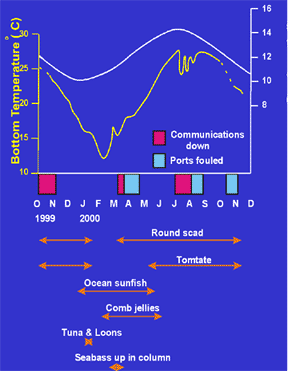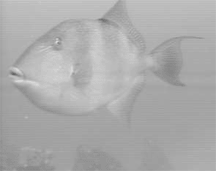Potential for coupling of underwater TV monitoring with
passive acoustics
Charles A. Barans, David Schmidt, Myra C. Brouwer*
Sonic signatures of some fishes have been corroborated with
visual observations, yet many more are needed to assist in interpretations
of sonic data from hydrophones placed in complex habitats with many interacting
species of vertebrates and invertebrates. The underwater television (UWTV)
is ideal for direct correlations between specific sounds and their causes,
if the water visibility is acceptable.
Underwater video devices can provide a wealth of information to scientists
and fishery managers including seasonal movements of fishes, the potential
for development of indices of abundance for some migrating and resident
populations, and any seasonal behaviors associated with the formation
of pre-spawning aggregations along a migration route. An UWTV system offshore
allows the study of fishes on the bottom throughout the year without the
costly trips to a research site in inclement weather. The present visual
capability of UWTV should be integrated with acoustic information to enhance
fisheries biologists’ understanding of fish behavior and movements
within the region. Herein we describe recent results from a permanent
installation of an UWTV at an artificial reef offshore.
The Underwater Television System
 The
research site was established in 25-28 m of water about 72 Km off central
Georgia on May 11, 1999 with the deployment of several large fish attraction
units (Artificial Reefs, Inc. The video system consists of two main parts.
A pressure housing, located on the sea floor and a video capture engine,located
remotely. Six monochrome video cameras are housed with a micro-controller
and a few basic sensors. File transfer and system parameter updates are
made possible by an interface between the web server and the console application
controlling the video system using pcANYWHERE.
The
research site was established in 25-28 m of water about 72 Km off central
Georgia on May 11, 1999 with the deployment of several large fish attraction
units (Artificial Reefs, Inc. The video system consists of two main parts.
A pressure housing, located on the sea floor and a video capture engine,located
remotely. Six monochrome video cameras are housed with a micro-controller
and a few basic sensors. File transfer and system parameter updates are
made possible by an interface between the web server and the console application
controlling the video system using pcANYWHERE.
Daily observations (~65) were conducted between 1200 and 2130 GMT (Greenwich Mean Time). Still images were recorded and logged at 10 minute intervals for 10 sec. Video clips were recorded on the hour from camera No. 5, since only camera No. 5 was directed at reef structure with any reef fish activity. Images were downloaded from the remote computer to the laboratory computer for fish counts and long-term data storage.
Observations using UWTV
 We
have temporally documented species presence and activity. The seasonal
dates of the first appearance of various fish species are especially important
for identification of any prespawning migration to the south by adult
grouper, one of our main target species. Seasonal changes in the makeup
of the fish assemblage at the UWTV site appear much greater than previously
believed. We are documenting the annual cycle of juvenile recruitment
in spring and summer followed by intense predation by transient species
later in the year.
We
have temporally documented species presence and activity. The seasonal
dates of the first appearance of various fish species are especially important
for identification of any prespawning migration to the south by adult
grouper, one of our main target species. Seasonal changes in the makeup
of the fish assemblage at the UWTV site appear much greater than previously
believed. We are documenting the annual cycle of juvenile recruitment
in spring and summer followed by intense predation by transient species
later in the year.
Large schools of bait fish have been present in most seasons accompanied
by schools of predatory greater amberjacks. The subjects of interest to
us, snapper and grouper species, however, have yet to establish resident
populations at the site.
Year-round resident species included Atlantic spadefish, gray triggerfish,
black seabass, and great barracuda. Other resident species may not have
been observed due to decreased visibility and/or increased cryptic behavior
during winter.
Although resident predators must significantly reduce recruitment of many
species, large predation events appear to have a formidable influence
on mortality and survival of small and juvenile reef fishes. Two important
large-scale predation events observed in 1999-2000 were the arrival of
migrating loons and the mid-winter appearance of large populations of
ctenophores near the bottom.
 We
observed the loons to visually select fish prey in and near the structural
reef units within a meter of the bottom. Also, the large numbers of ctenophores
and/or jellyfish in winter corresponded to the temporary residence of
an ocean sunfish and a relatively large population of adult Atlantic spadefish.
Both species are known to feed on jellyfish
We
observed the loons to visually select fish prey in and near the structural
reef units within a meter of the bottom. Also, the large numbers of ctenophores
and/or jellyfish in winter corresponded to the temporary residence of
an ocean sunfish and a relatively large population of adult Atlantic spadefish.
Both species are known to feed on jellyfish
The primary scientific objective of the UWTV system established off Georgia
was to document and quantify prespawning aggregations of gag grouper as
they move south along the continental shelf. If an associated sound recognition
pattern were associated with such fish aggregations and movements, multiple
listening stations could be established at key locations across the shelf
and along the potential migration path at a cost for monitoring much less
than that using other methods. The visual findings of the present UWTV
study expand our understanding of the importance of large scale stochastic
predation events on relatively localized reef fish aggregations, especially
of juveniles and bait species. The sounds generated by the assemblage
interactions would have filled chapters of a catalog on reef fish sounds.
Synergistic information would come from the simultaneous combination of
visual and sonic information. The addition of less expensive, passive
acoustic data gathering devices could compensate for the lack of spatial
coverage by more expensive UWTV systems. It could also provide more complete
coverage of the events taking place in the vicinity of the cameras, but
beyond their field of view. The scientific community anxiously awaits
the development and application of tools that will allow simultaneous
visual and sonic investigations of fish associations and behaviors.